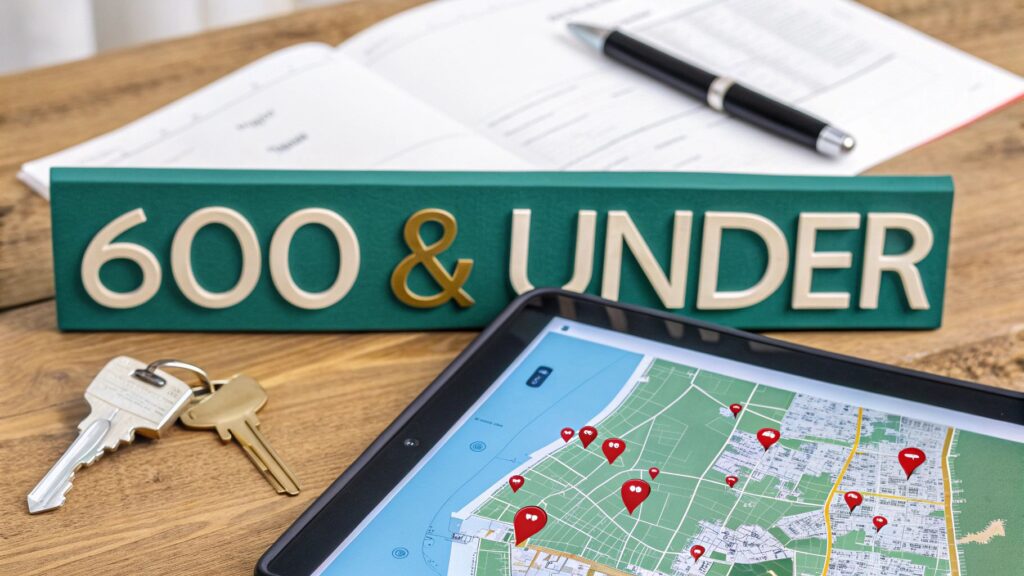Let's be honest, searching for an apartment under $600 in Boca Raton can feel like searching for a needle in a haystack. But I'm here to tell you it's not impossible. You just need a different playbook—one that goes beyond the standard advice and gives you a real-world strategy for landing a great place without breaking the bank.
A Smarter Way to Hunt for Your Apartment
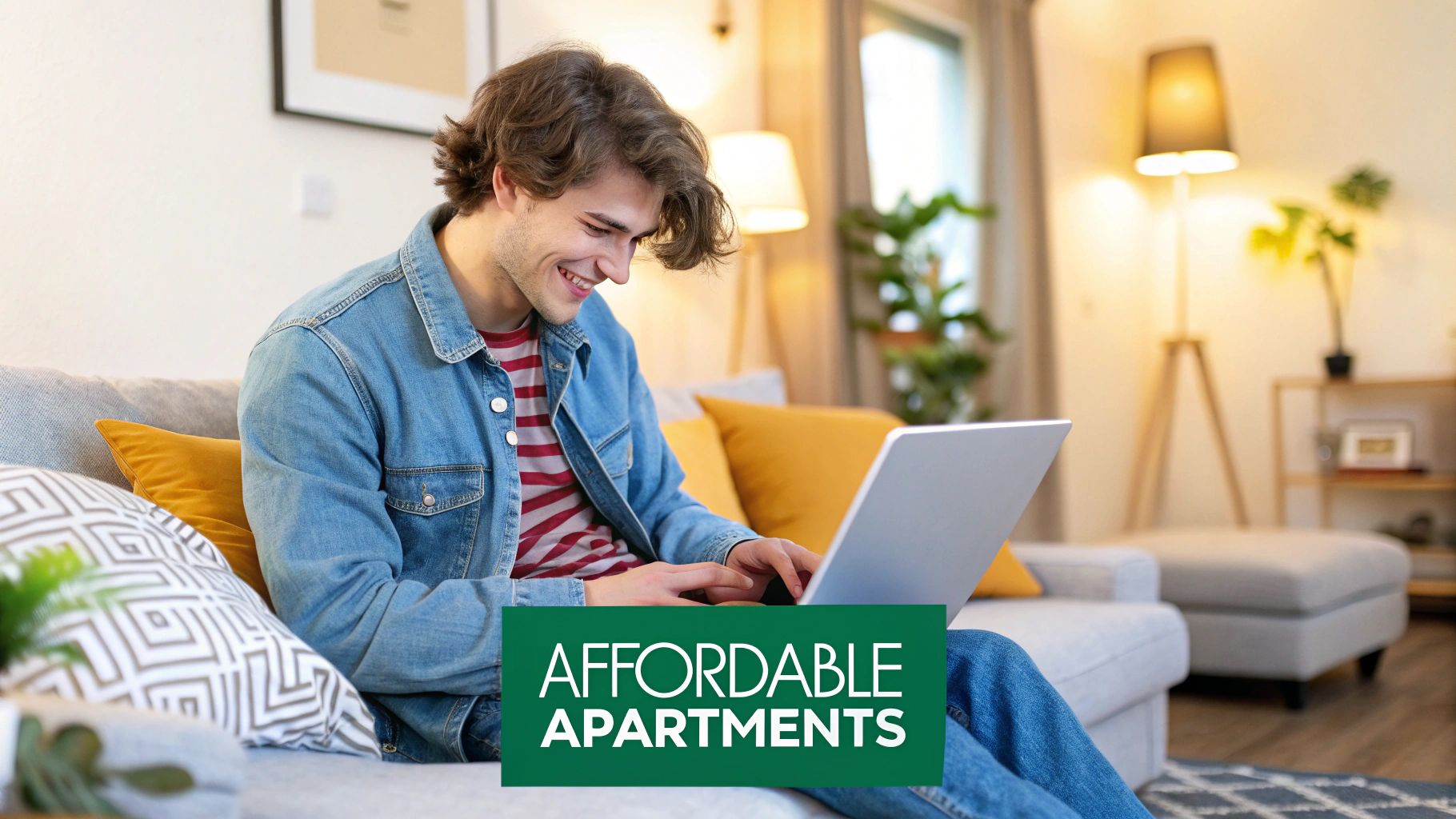
When your budget is tight, just filtering by price on the big rental sites won't cut it. You have to get creative and proactive. Finding a gem in this price range is all about knowing where to look, what to look for, and being ready to pounce when you find it.
We're going to dive into some unconventional search tactics, smart roommate setups, and how to spot value in communities you might have otherwise overlooked. I'll even use a place like Cynthia Gardens as a real-world example of what a quality, affordable community looks like—proving you don’t have to sacrifice a good location for a good price.
Why Is It So Hard to Find an Affordable Place?
It boils down to simple supply and demand. The competition for budget-friendly housing in Boca is fierce. While you might see brand-new luxury towers with vacancy rates around 7.8%, the more affordable properties—the ones with apartments in our target range—have much lower vacancies, often hovering near a tight 5%.
That kind of competition means you can't just casually browse; you need a game plan.
My goal here is to give you a realistic perspective and a solid set of tools. I want you to walk away feeling confident that you can navigate Boca's rental market and find a home that genuinely works for you.
To get there, we'll focus on three core ideas:
- Flexibility is your superpower. Being open to different neighborhoods or sharing your space with a roommate will instantly multiply your options.
- Preparation wins the race. When a great listing pops up, having your documents in order and your deposit ready gives you a massive advantage.
- Look for value, not just flash. A well-maintained community with the essentials you actually need is a much smarter choice than a brand-new building with pricey amenities you'll never use.
Getting a handle on these market realities is your first step. For a deeper dive into the numbers, you can check out our detailed breakdown of the average rent prices in Boca Raton to get a clearer picture of what you're up against.
How to Master Your Apartment Search
Finding great apartments 600 and under in a place like Boca Raton means you have to think differently than the average renter. Forget just setting a price filter and hoping for the best. To find those hidden gems that most people miss, you'll need to blend some clever online searching with a bit of old-school, on-the-ground investigation. The real secret is knowing where to look and how to spot value that goes beyond the monthly rent check.
This whole process is about moving from a wide digital search to a very specific, in-person hunt.
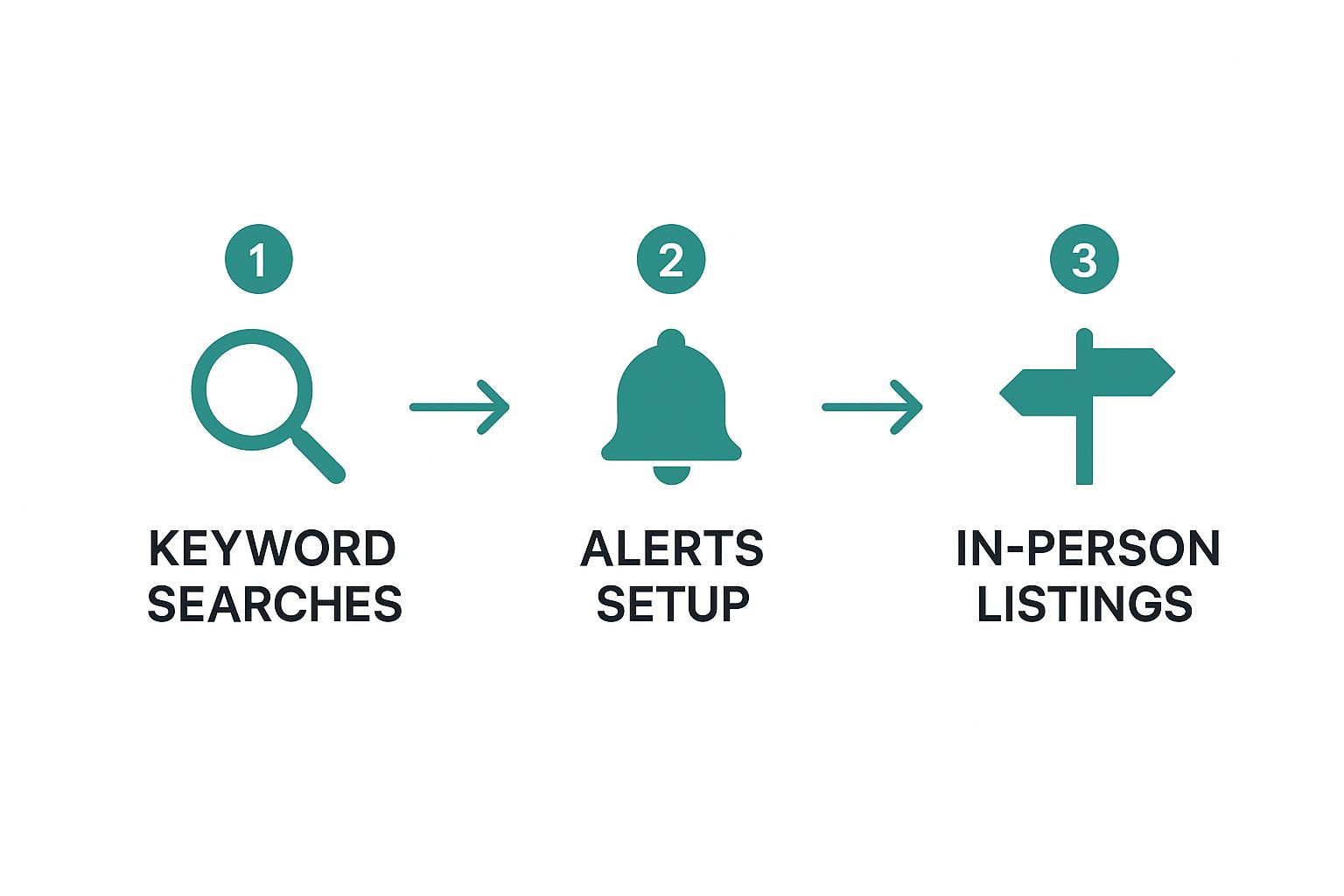
As you can see, the search might begin on your laptop, but it often ends with discovering a place you never would have found otherwise.
Broaden Your Digital Toolkit
Start by casting a wide net online, but do it with a plan. Instead of just typing "apartments" and "$600" into a search engine, you need to get creative, especially on platforms like social media marketplaces where private landlords often post.
Try to think like someone who isn't a professional property manager. They might use different language. Search for phrases like:
- "Room for rent Boca"
- "Studio near FAU"
- "In-law suite for lease"
- "Private entrance efficiency"
These terms can uncover listings from individual owners who skip the big rental websites. And on those traditional sites? Get granular with your alerts. Don't just set a single price cap. Create several alerts for different neighborhoods and building types so you get a notification the second a promising listing appears. In this market, speed is everything.
Filter for Total Value, Not Just Rent
That $600 price tag can be a bit of an illusion if you're not looking at the complete picture. An apartment listed at $575 might seem like a steal, but what happens when you add in water, trash fees, and a $50 monthly parking spot? Suddenly, you're well over your budget.
On the flip side, a place listed at $625 could actually be a phenomenal deal if it includes all utilities and a dedicated parking space. When you're searching, always dig into the listing details or look for filters that let you specify "utilities included." This small shift in how you think—from just rent to total monthly cost—is absolutely crucial for staying on budget.
Remember, the cheapest rent doesn't always mean the most affordable living situation. Your goal is to find the best overall value, which includes what you get for your money, not just what you pay upfront.
Timing and Preparation Are Everything
The rental market ebbs and flows, especially in a college town. Here in Boca Raton, demand goes through the roof right before the fall and spring semesters start. If your timeline is flexible, aim your search for the off-season, like mid-winter or late summer. Landlords are often more eager to fill vacancies then and might be more willing to negotiate.
Once you find a place you like, you have to be ready to pounce. Good, affordable apartments, particularly those 600 and under, can receive a flood of applications within hours of being listed. Get all your paperwork organized and scanned into a digital folder ahead of time.
Your 'Go-Bag' of Documents:
- Proof of Income: Your most recent pay stubs or an employment offer letter.
- Photo ID: A clean, clear digital copy of your driver's license.
- References: Contact info for past landlords or employers who can vouch for you.
- Application Funds: Be prepared to immediately pay the application fee and security deposit.
Being the first person to submit a complete, organized application can make all the difference. Landlords appreciate tenants who are proactive and have their act together—it often puts you right at the top of their list.
Your Budgeting and Application Game Plan
https://www.youtube.com/embed/XwXzmcxlz5M
So, you found a promising apartment. Great! But that’s just getting to the starting line. To actually snag one of those rare apartments for $600 and under, you need a rock-solid financial plan and an application that screams "ideal tenant." This isn't something you throw together at the last minute; preparation is everything.
Remember, the real cost of moving in is much more than just the first month's rent. You have to account for the security deposit (which is often another full month's rent), plus non-refundable application fees and those pesky utility connection charges. Forgetting about these upfront costs is a quick way to have your plans fall apart.
Assembling Your Application Toolkit
Think of your rental application as your personal resume for a landlord. A well-organized, complete package shows you're serious and responsible. Landlords are sifting through stacks of these, so anything you can do to make their job easier gives you a serious leg up.
Before you even start looking, get a digital folder ready and fill it with these essentials:
- Proof of Income: Your last two or three pay stubs are the gold standard. If you’re new to a job, a formal offer letter on company letterhead will usually do the trick.
- Identification: Have a clear digital copy of your driver's license or another government-issued photo ID ready to go.
- References: Line up contact info for at least one previous landlord and a professional reference, like a boss or supervisor. Give them a heads-up so they expect a call!
- Credit Report: You can pull your own credit report for free. Check it for any mistakes and know your score. It’s always better to address potential issues yourself before a landlord discovers them.
While it's geared toward buyers, a good first home buyer's checklist can be a lifesaver here. The principles of getting your financial documents in order are nearly identical and will help you stay organized.
Having everything prepped is crucial. To make it even easier, here's a quick rundown of what you'll need.
| Document Type | What to Prepare | Pro Tip |
|---|---|---|
| Proof of Income | Last 2-3 pay stubs, offer letter, or recent tax returns. | Convert all documents to PDF and name them clearly (e.g., "JaneDoe_Paystub_May2024.pdf"). |
| Identification | Driver’s license, state ID, or passport. | Make sure the image is clear, legible, and not expired. |
| Bank Statements | The two most recent monthly statements. | This shows you have the funds for the deposit and first month's rent. Black out account numbers for security. |
| Reference List | Names, phone numbers, and emails for past landlords and a professional contact. | Always ask your references for permission before listing them. A surprised reference is not a good reference. |
| Credit Report | A recent copy of your credit report from a major bureau. | Landlords will run their own, but having yours helps you prepare for any tough questions. |
| Cover Letter | A brief, optional letter introducing yourself. | This is your chance to make a personal connection and explain any potential red flags in your application. |
Getting these items in order before you apply shows landlords you're proactive and reliable—exactly the kind of tenant they’re looking for.
Navigating Credit Score Hurdles
What if your credit score isn't perfect? First, don't panic. While many landlords hope for scores over 600, it's rarely an automatic "no." The real key is how you handle it.
If you know your score is on the lower end, get out in front of it. You can write a short, professional letter explaining what happened and—more importantly—what you’ve done to get back on track. Highlighting a perfect payment history since that blip can work wonders.
In some cases, you might be able to offer a slightly larger security deposit (check local laws first) or provide an absolutely glowing reference from a previous landlord. These gestures can go a long way in strengthening your application.
This level of competition isn't just a Boca Raton thing. The global housing crisis has made affordable rentals scarce everywhere. Hines Research points to a staggering worldwide housing shortage of 6.5 million units, which just amps up the pressure. You can dive deeper into these global housing trends on deloitte.com.
The best strategy is to present yourself as the solution to a landlord’s biggest problem: finding a reliable tenant who pays on time and takes care of the property. Your preparedness and honesty can speak volumes.
At the end of the day, it’s all about building trust. When you have every document ready to go and a clear plan to address any potential weak spots, you stop being just another name in the pile and become a top-tier candidate. If you're looking for more ways to make your budget stretch, check out our guide on how to save money on rent.
Getting a Real Feel for the Place and the Neighborhood
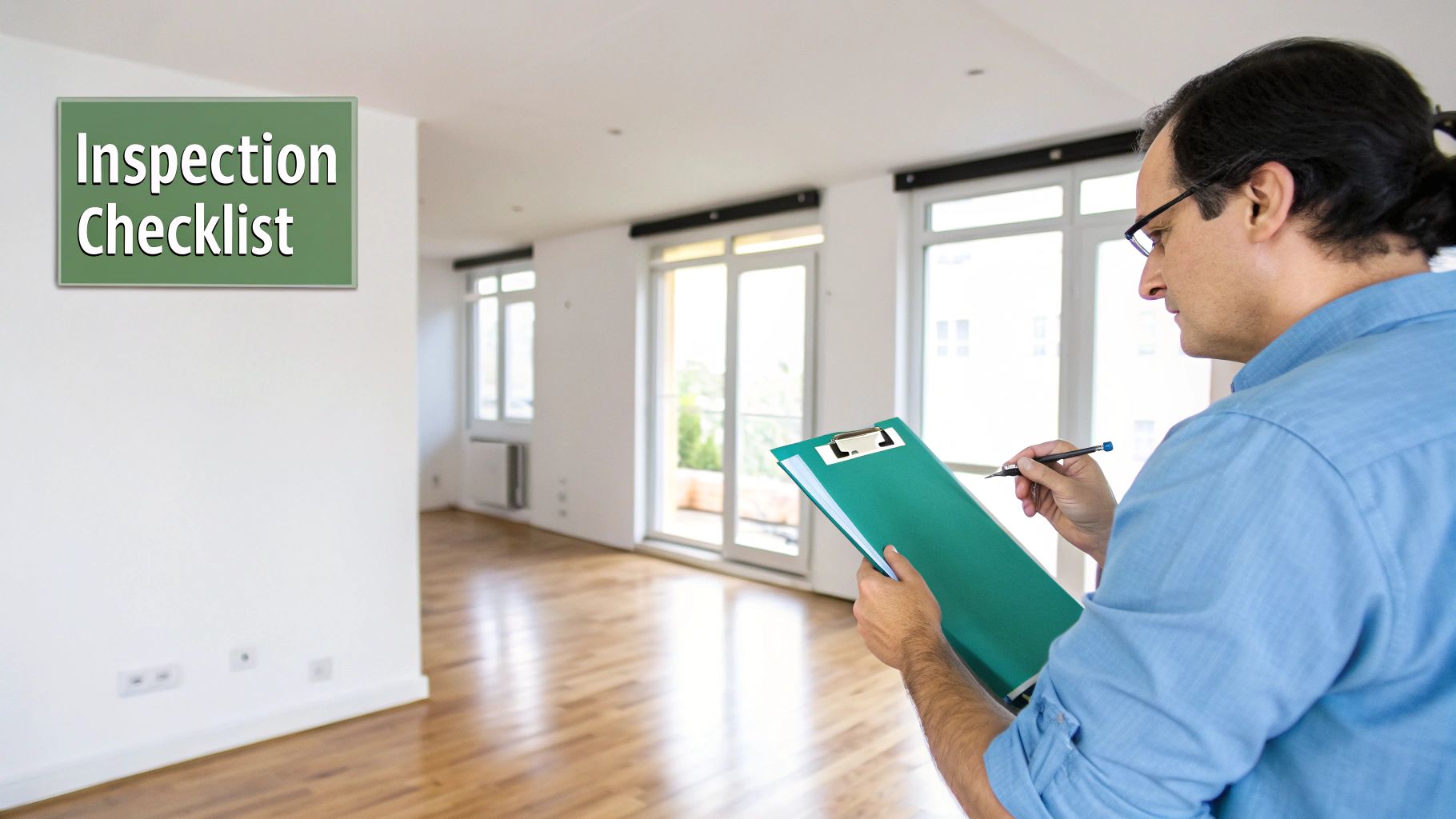
Alright, you've got a shortlist of potential apartments for 600 and under. Now comes the part where you separate the hidden gems from the money pits. A quick walk-through won't cut it; you have to dig in and really inspect what you’re getting for your money. This is your best defense against signing a lease you'll regret a month later.
Don't get distracted by a fresh coat of paint or some new flooring. Your job is to look for the little details that reveal the true condition of the unit and the building. Think of yourself as a home inspector for a day—your future comfort depends on it.
The In-Person Inspection: Be Thorough
When you step inside a potential apartment, trust your gut and your senses. Does it smell musty? That could be a red flag for mold or plumbing issues. Don't be shy about getting hands-on.
Turn on the faucets and shower to check the water pressure. Flush the toilets. Flick every light switch. I even suggest bringing your phone charger to test the outlets and, just as importantly, see what your cell service is like. A dead zone right where your couch would go is a modern-day nightmare.
Look for the subtle clues:
- Under the Sinks: Peek underneath every sink for signs of past leaks, water damage, or pest traps. It’s a classic trouble spot.
- Appliances: Ask the leasing agent if you can see the major appliances run for a moment. Does the fridge feel genuinely cold? Does the AC actually blow cold air?
- Windows and Doors: Open and close everything. Make sure they lock securely. A window that doesn’t seal properly isn’t just a security risk—it's a one-way ticket to higher energy bills.
To keep everything straight, especially after seeing a few places, a checklist is your best friend. We actually created a detailed apartment viewing checklist to help you remember what to look for.
Vetting the Neighborhood: It's More Than Just the Walls
The apartment is only half the story; the neighborhood is the other. Where you live impacts your commute, your safety, and your sanity. Drive or walk through the area at different times.
A quiet street on a Tuesday morning can have a completely different vibe on a Friday night. Experiencing the neighborhood at various times gives you a more accurate picture of what it’s actually like to live there.
Map out your daily-life logistics. How far is the nearest grocery store? The laundromat? The bus stop? A slightly cheaper apartment that adds a 30-minute trek to your daily commute might not be the great deal it seems. If you see a neighbor outside, don't hesitate to politely ask them what they think of the place. Their unfiltered opinion on management or maintenance is pure gold.
Considering the Bigger Picture
While you're hunting for one of the few apartments for 600 and under, it helps to remember the market you're in. The rental market is tight everywhere. The average U.S. apartment rent is hovering around $1,773, and with vacancy rates at about 8.2%, landlords aren't struggling to find tenants. That pressure makes it even more critical to do your homework and choose wisely.
And don't forget to look beyond the first month's rent. You'll need to furnish your new place. It's smart to start looking into finding stylish and affordable furniture solutions for small apartments now so you can factor that into your total moving budget.
What to Look For in an Affordable Community
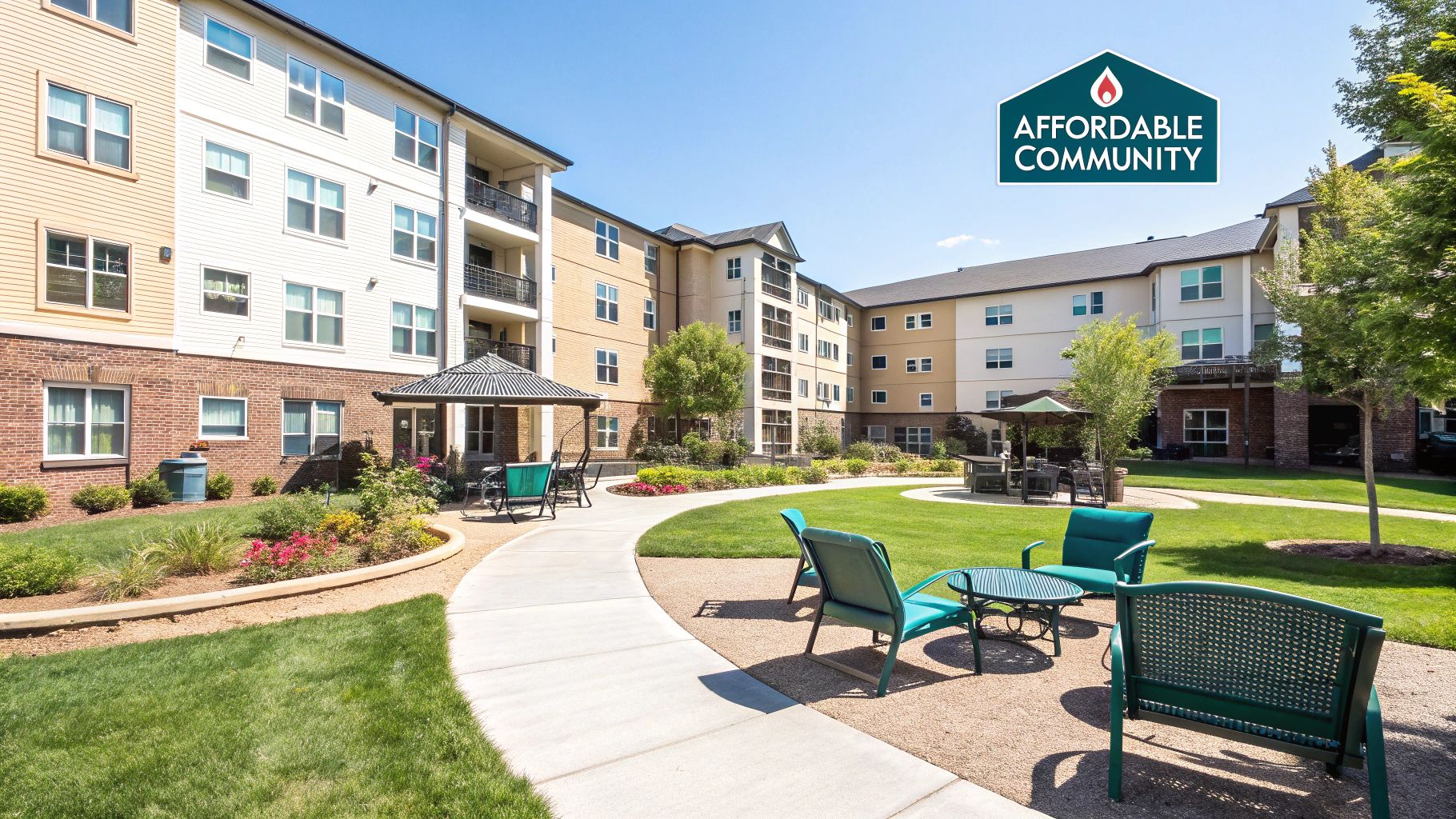
Finding a listing that actually says "apartments 600 and under" feels like striking gold, but that's just the beginning. The real challenge is finding a place that delivers genuine value—a community where "affordable" doesn't translate to "run-down."
So, how do you spot the difference? Let's use a well-managed property like Cynthia Gardens as a real-world benchmark. This isn't a sales pitch; it's a field guide to help you recognize a great deal when you see one. By knowing what to look for, you can tell a cheap apartment from a truly valuable home.
Practical and Efficient Floor Plans
When you're hunting for deals in this price range, every square foot matters. A great affordable community knows this and designs its units for living, not just for show.
Forget sheer size—focus on the layout. Does the apartment feel open and intuitive, or is it a maze of awkward hallways that eat up valuable space? Think about your daily routine. Smart layouts will have closets where you need them, a kitchen that actually works for cooking, and outlets in logical spots. A community that offers thoughtful designs, like the one-bedroom layouts you might find at Cynthia Gardens, clearly understands what its residents need to live comfortably.
Useful Amenities That Actually Matter
Rooftop pools and private movie theaters are nice, but they're also why some rents are astronomical. A truly smart affordable community invests in practical features that make your life easier without padding the price.
Be on the lookout for amenities you will genuinely use day-to-day:
- On-Site Laundry: This is a game-changer. It saves you from weekly trips to the laundromat, which costs you both time and money.
- Responsive Maintenance: An on-site maintenance team is a huge plus. It means a leaky faucet gets fixed today, not next week.
- Sufficient Parking: Don't overlook this. Finding a reliable place to park your car can be a major headache and expense in many areas.
- Well-Kept Grounds: Clean landscaping and well-maintained common areas are a dead giveaway that management cares about the property and the people who live there.
These are the things that improve your quality of life without breaking your budget.
An affordable community’s value isn’t in its flashy extras; it’s in how well it delivers on the essentials. Consistent maintenance, practical amenities, and a convenient location are the hallmarks of a place you’ll be happy to call home.
A Location That Saves You Time and Money
That low rent figure can be misleading if you’re spending a fortune on gas and an hour in traffic every day. Think of a great location as a money-saving amenity in its own right.
Being close to your job or school, like Florida Atlantic University, can slash your transportation costs and give you back precious time. Plus, having grocery stores, bus stops, and other essentials just around the corner adds a layer of convenience that's hard to put a price on. A strategically located community lets you live more and commute less—turning a good deal into a great one.
Answering Your Top Apartment Hunting Questions
Searching for apartments 600 and under in Boca Raton will definitely spark a few questions. Even when you have a game plan, you're bound to hit a snag or just wonder if you're missing a crucial piece of the puzzle. Let's dig into some of the most common things renters ask when hunting in this tough price range.
Is It Actually Possible to Find an Apartment for $600 in Boca Raton?
The short answer? Yes, but you have to be clever and flexible about it. If you're picturing a traditional one-bedroom in a trendy downtown building for exactly $600, you'll likely be disappointed. The real magic happens when you adjust what you're looking for.
Success at this price point usually looks like one of these scenarios:
- Renting a room within a larger house or apartment.
- Finding a roommate to split a two-bedroom, which instantly cuts your share down, often well below the $600 mark.
- Snagging a studio or efficiency apartment in an older, but solid, building that's a bit further from the main city buzz.
Your victory will come down to being persistent, keeping an open mind about different neighborhoods, and having your paperwork locked and loaded. When a great spot pops up, you have to be ready to act immediately. Those unconventional search tactics we talked about earlier? They’re your golden ticket.
What Are the Biggest Red Flags to Watch Out For?
When you’re looking at apartments this affordable, your scam-radar needs to be turned all the way up. An apartment that seems way too good to be true probably is.
Be on high alert if you run into any of these warning signs:
- A landlord demands a big cash deposit or the first month's rent before you’ve even seen a lease.
- They’re being cagey or flat-out refuse to let you see the actual unit you’d be renting.
- The online listing is a mess—think terrible grammar, generic stock photos, or no photos at all.
A legitimate landlord will always give you a formal lease to review before any money changes hands. Never, ever send cash for a security deposit or application fee without touring the property in person and confirming the owner is who they say they are.
How Can I Make My Application Stand Out with a Limited Income?
At the end of the day, landlords want one thing: a tenant who is reliable and pays rent on time. If your income just barely clears their typical requirement (usually 3x the monthly rent), you can still make your application shine by building a strong case for yourself.
Here are a few power moves to consider:
- Gather glowing references from past landlords or even employers who can vouch for your responsibility.
- Show off a great credit score. A history of paying your bills on time can go a long way in easing a landlord’s concerns about a borderline income.
- Write a short, professional cover letter. Use it to introduce yourself and briefly explain why you'd be a fantastic, low-maintenance tenant.
- Offer to set up automatic rent payments. This is a clear signal that you’re serious about paying on time, every single month.
Just by being organized, professional, and quick to respond, you show that you're a serious applicant. Often, that can make you more appealing than someone with a higher income who comes across as flaky.
Should I Consider a Roommate to Stay Under Budget?
For most people, this is a game-changer. Teaming up with a roommate is often the single best way to land a great place without breaking the bank. Suddenly, a $1,200 two-bedroom apartment becomes perfectly affordable when your share is only $600.
Going the roommate route opens up a whole new world of possibilities—nicer locations, better amenities, and more space than you could ever get on your own for that price. Just make sure you protect your sanity by drafting a clear roommate agreement. Put everything in writing: finances, chores, guests, and general house rules. It’ll save you a ton of headaches down the road.
Ready to find an affordable and comfortable home in a prime Boca Raton location? At Cynthia Gardens, we offer serene, well-maintained one-bedroom apartments that provide incredible value. Explore our community and see how great affordable living can be.
